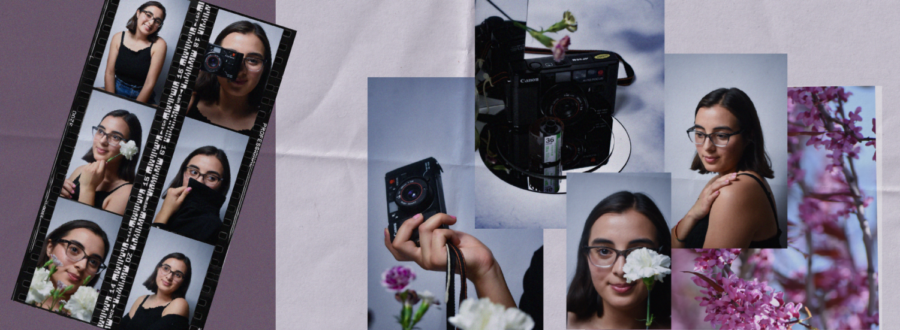Jasmin Campoya
July 18, 2022
Editors note: In effort of full disclosure, Jasmin Campoya is the photo-editor for Minero Magazine in the Spring 2022-Fall 2022 semester.
Sitting in a make-shift photo studio inside of a garage of an east El Paso home, photographer, student, server, band-member and local business owner Jasmin Campoya said in her 5-year photography career, she had never been in front of a camera, at least, one that was not her own.
Campoya started taking photos at 16 years old, during her freshman year of high school, using a Sony A6 camera that her father had gifted her for her birthday.
Her first photos captured landscapes, scenery and anything else she saw during a trip to Austin, Texas, all of which she published on the Instagram account @jasmincphoto. Quickly, her family members took notice of her photos and a tía suggested Campoya take her cousin’s graduation photos. From there, her photography business grew to what it is today: printmaking and photography under her name.
With two semesters left before she graduates with a degree in digital media production, Minero Magazine’s Spring 2022 photo-editor talks about the courage it takes to start a self-named photography business in a field that is notoriously difficult to make a name in.
Here is what she had to say:
Brandy: Where did you start and where are you now?
Jasmine: One of the first grad-photos I did was my cousin’s. And then I was like, “Oh, that was like really fun.” I was so nervous though. Because those were the first photos that anybody had ever hired me to do.
So after that, I was like, “Oh, that’s really cool”… I just wanted to like stick to it, to do it for fun and then my cousin posted his photos. So then, a few of his friends were like, ‘Oh, you want to take my grad photos?’ And I was like, ‘Well, I don’t really do that’. I was, I don’t know, barely starting out. So I literally would charge like $20 for a shoot and then give them like 50 photos and like looking back… (charging) that was so cheap!
There’s so much competition within the photography community. It’s kind of difficult but I just kept shooting and stuff. And then, maybe when it was like…2019- 2020 when COVID hit I then started taking photography more seriously in those years. I made my website and then I started shooting film, and I really liked shooting film a lot. I think it was cool how I would have to wait for my photos. And I think it made me appreciate my photography a lot more. So that’s when I started printing all my photos and I really liked it because I just wanted to put them all in my room.
Brandy: So do you do all your prints and make your canvases from your home? How expensive is that and why did you start?
Jasmine: At the time, when COVID hit, no one booked me and back then I was scared because I didn’t want to get COVID. So I would tell people: I’m sorry, I can’t do your photoshoot. I don’t want to get sick, you know, or risk it or anything like that. So then I started shooting film (again) and I was like, well maybe I could make money off selling my photos.
I would take a bunch of photos and I was like, “imagine if someone got this photo and put it in their room or like in their kitchen or something.” So we bought equipment and then for canvases we just go buy wood. My dad makes frames and everything and then I staple it.
It was really expensive. My dad had already had a few printers so he knew a lot about printers. I wouldn’t have been able to do it at all without my dad because he has so much knowledge about all that and technology. Then, I thought: “Well, I don’t want to just have little prints or like don’t have big prints.” So we ended up buying a Canon printer which prints up to a 24×36. They’re super expensive, but it was really nice. We were like: if we sell this much it’s like a good investment, you know? I mean like I’m still trying to grow that (side of the business) too because I’m trying to grow my print shop.
Brandy: You started out charging $20 flat for 50 photos and now you take photos, print them and build canvases all in your home. Can you talk about your experience being a woman photographer in El Paso, who has run her own printing and photography business, all while balancing school and work?
Jasmin: I do have some days that I’m overwhelmed but I’m the type of person to always be wanting to do something. I don’t like being bored at home. I honestly think I’m able to balance everything really well and I really love El Paso. I’ve thought about moving but I think I built like my clientele here and even if I’m not a huge business right now, I hope to keep growing, especially within El Paso and even meet other photographers here because I see that they’re friends and I just think that’s so cool.
Brandy: What is a piece of advice you can give to somebody who is just starting out?
Jasmine: Social media is really big, especially Instagram. One thing I found out was like post who you are, a personality because say if I’m trying to book someone and I don’t know what they look like, I most likely won’t book them. I mean, I want to- especially with the photographer, I want to feel like I know them or like I can trust them.
You can find Jasmin on instagram @jasmincphoto or book through her website jasmincphoto.com
